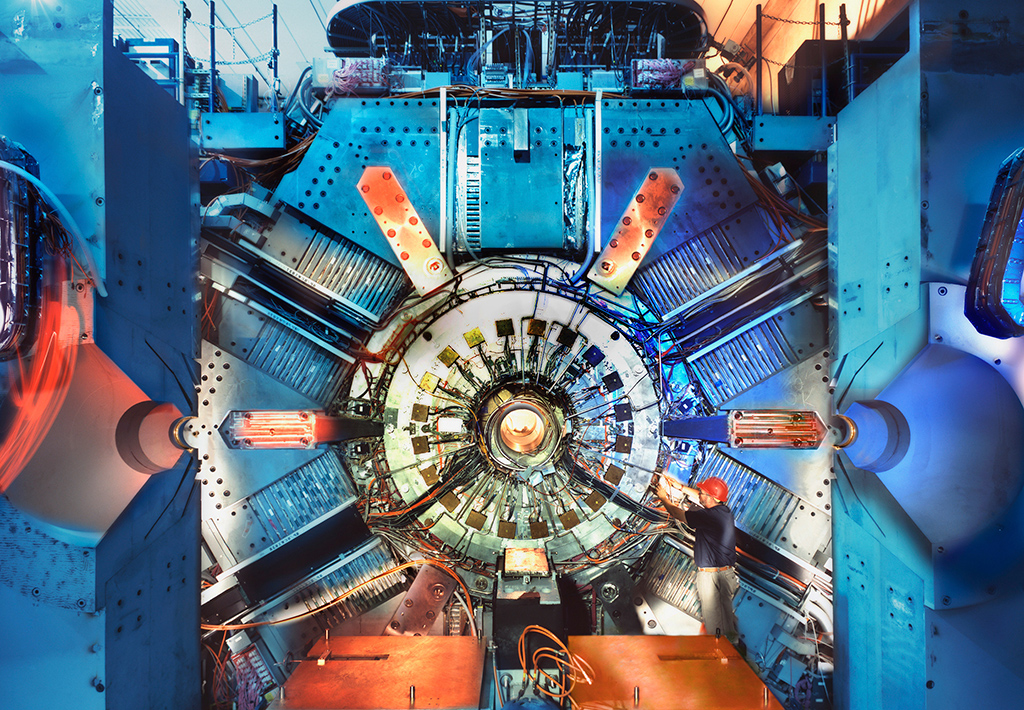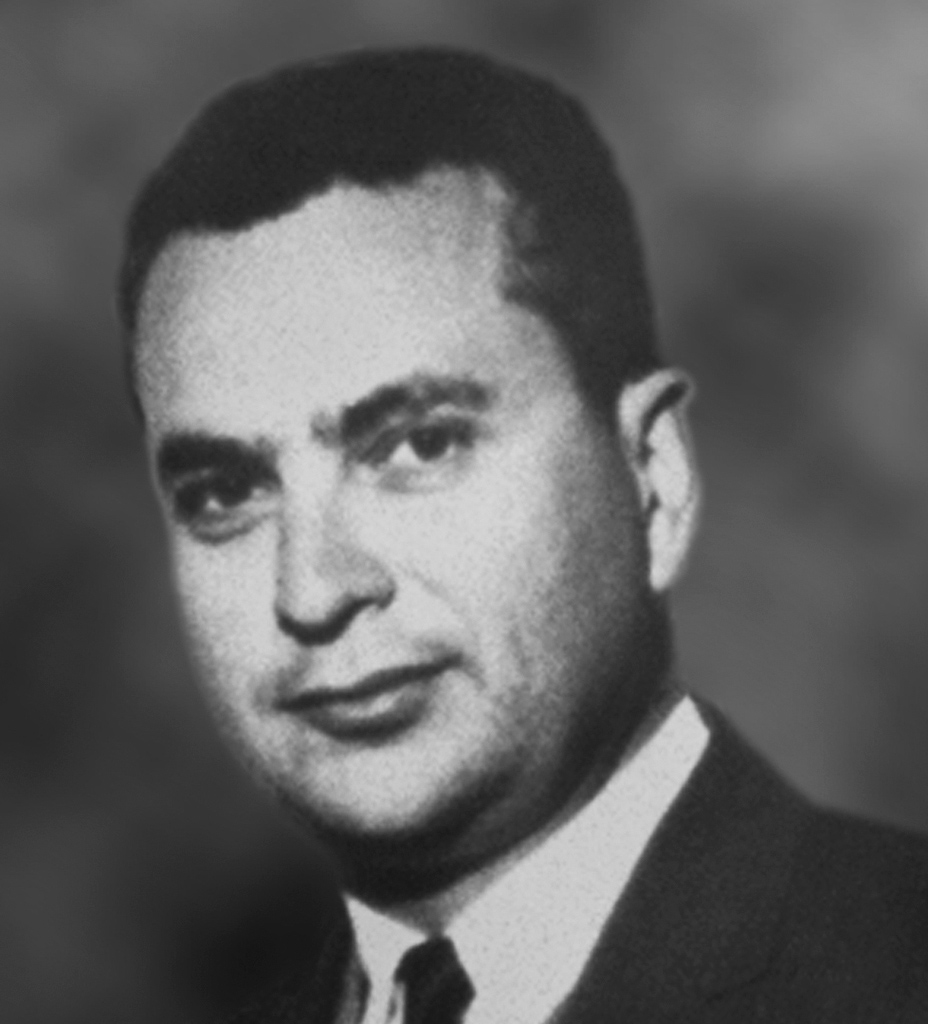
IN CONTEXT
Physics
1932 A new particle, the neutron, is discovered by James Chadwick. There are now three known subatomic particles with mass: the proton, neutron, and electron.
1932 The first antiparticle, the positron, is discovered.
1940s–50s Increasingly powerful particle accelerators – which smash particles together at high speeds – produce large numbers of new subatomic particles.
1964 The discovery of the omega (Ω–) particle confirms the quark model.
2012 The Higgs boson is discovered at CERN, adding weight to the standard model.
Understanding of the structure of the atom has changed dramatically since the end of the 19th century. In 1897, J J Thomson made the bold suggestion that cathode rays are streams of particles far smaller than the atom; he had discovered the electron. In 1905, building on the light quanta theory of Max Planck, Albert Einstein suggested that light should be thought of as a stream of tiny massless particles, which we now call photons. In 1911, Thomson’s protégé Ernest Rutherford deduced that an atom’s nucleus is small and dense, with electrons in orbit around it. The image of an atom as an indivisible whole had been destroyed.
In 1920, Rutherford named the nucleus of the lightest element, hydrogen, the proton. Twelve years later, the neutron was discovered, and a more complex picture of nuclei made of protons and neutrons emerged. Then, in the 1930s, a glimpse of further realms of particles came from studies of cosmic rays – high-energy particles that are thought to originate in supernovae. The studies revealed new particles associated with high energies, and hence with greater masses according to Einstein’s principle of mass–energy equivalence (E = mc2).
Seeking to explain the nature of interactions inside the atomic nucleus, scientists in the 1950s and 1960s produced an enormous body of work providing the conceptual framework for all matter in the Universe. Many figures contributed to this process, but American physicist Murray Gell-Mann played a pivotal role in the construction of a taxonomy of fundamental particles and force- carriers called the standard model.

"How can it be that writing down a few simple and elegant formulae can predict universal regularities of Nature?"
Murray Gell-Mann
The particle zoo
Gell-Mann jokes that the goals of the theoretical elementary particle physicist are “modest” – they aim to explain merely the “fundamental laws that govern all matter in the Universe”. Theorists, he says, “work with pencil, paper, and wastebasket, and the most important of those is the last”. By contrast, the experimentalist’s principal tool is the particle accelerator, or collider.
In 1932, the first atomic nuclei – of the element lithium – were blown apart by physicists Ernest Walton and John Cockcroft using a particle accelerator in Cambridge, England. Since then, ever more powerful particle accelerators have been constructed. These machines boost tiny subatomic particles to nearly the speed of light before slamming them into targets or each other. Research is now driven by theoretical predictions – the largest particle accelerator, the Large Hadron Collider (LHC) in Switzerland, was built primarily to find the theoretical Higgs boson. The LHC is a 27-km (17-mile) ring of superconducting magnets that took 10 years to build.
Collisions between subatomic particles splinter them into their core units. The energy released is sometimes enough to produce new generations of particles that cannot exist under everyday conditions. Showers of short-lived, exotic particles spray off these pile-ups, before swiftly annihilating or decaying. With ever-increasing energies at their disposal, researchers aim to probe the mysteries of matter by getting even closer to the conditions at the birth of matter itself – the Big Bang. The process has been likened to smashing two watches together and then sifting through the wrecked pieces in an attempt to find out how the timepiece works.
By 1953, with colliders achieving ever-increasing energies, exotic particles not found in ordinary matter seemed to tumble out of thin air. More than 100 strongly interacting particles were detected, all thought at the time to be fundamental. This merry circus of new species was dubbed the “particle zoo”.

The Stanford Linear Accelerator in California, built in 1962, is 3km (2 miles) long – the longest linear accelerator in the world. It was here, in 1968, that it was first demonstrated that protons are composed of quarks.
The Eightfold Way
By the 1960s, scientists had grouped particles according to how they were affected by the four fundamental forces: gravity, electromagnetic force, and the weak and strong nuclear forces. All particles with mass are influenced by gravity. The electromagnetic force acts on any particle with an electric charge. The weak and strong forces operate over the miniscule ranges found within the atomic nucleus. Heavyweight particles called “hadrons”, which include the proton and neutron, are “strongly interacting” and influenced by all four fundamental forces, while the lightweight “leptons”, such as the electron and neutrino, are unaffected by the strong force.
Gell-Mann made sense of the particle zoo with an octet ordering system he called the “Eightfold Way”, a pun on the Buddhist Noble Eightfold Path. Just as Mendeleev had done when arranging the chemical elements into a periodic table, Gell-Mann imagined a chart into which he placed the elementary particles, leaving gaps for as yet undiscovered pieces. In an effort to make the most economical scheme, he proposed that hadrons contained a new and as-yet-unseen fundamental subunit. Since the heavier particles were no longer fundamental, this change reduced the number of fundamental particles down to a manageable number – hadrons were now simply combinations of multiple elementary components. Gell-Mann, with his penchant for wacky names dubbed this particle a “quark” (pronounced “kwork”), after a favourite line from James Joyce’s novel Finnegans Wake.

The standard model arranges the fundamental particles in a table according to their properties. The Higgs boson, predicted by the model, was discovered in 2012.
"Three quarks for Muster Mark!"
James Joyce
Real or not real?
Gell-Mann was not the only person to suggest this idea. In 1964, a student at Caltech, Georg Zweig, had suggested that hadrons were made of four basic parts, which he called “aces”. The CERN journal Physics Letters refused Zweig’s paper, but that same year published a paper by the more senior Gell-Mann outlining the same idea.
Gell-Mann’s paper may have been published because he did not suggest that there was any underlying reality to the pattern – he was simply proposing an organizing scheme. However, this scheme appeared unsatisfactory, since it required quarks to have fractional charges, such as –1/3 and +2/3. These were nonsensical to accepted theory, which only allowed for whole-number charges. Gell-Mann realized that if these subunits remained hidden, trapped inside hadrons, this didn’t matter. The predicted omega particle (Ω–), made up of three quarks, was detected at Brookhaven National Laboratory, New York, soon after Gell-Mann’s publication. This confirmed the new model, which Gell-Mann has insisted should be credited both to him and to Zweig.
Initially, Gell-Mann was doubtful that quarks could ever be isolated. However, he is now at pains to say that although he initially saw his quarks as mathematical entities, he never ruled out the possibility that quarks might be real. Experiments at the Stanford Linear Accelerator Center (SLAC) between 1967 and 1973 scattered electrons off hard granular particles within the proton, revealing the reality of quarks in the process.
The standard model
The standard model developed from Gell-Mann’s quark model. In this scheme, particles are divided into fermions and bosons. Fermions are the building blocks of matter, while bosons are force-carrying particles.
The fermions are further split into two families of elementary particles – quarks and leptons. Quarks group together in twos and threes to make up the composite particles called hadrons. Subatomic particles with three quarks are known as baryons, and include protons and neutrons. Those made of a quark and antiquark pair are called mesons, and include pions and kaons. In total there are six quark “flavours” – up, down, strange, charm, top, and bottom. The defining characteristic of quarks is that they carry something called “colour charge”, which allows them to interact via the strong force. The leptons do not carry colour charge and are not affected by the strong force. There are six leptons – the electron, muon, tau, and the electron, muon, and tau neutrinos. Neutrinos have no electrical charge and only interact via the weak force, making them extremely hard to detect. Each particle also has a corresponding “antiparticle” of antimatter.
The standard model explains forces at the subatomic level as the result of an exchange of force-carrying particles known as “gauge bosons”. Each force has its own gauge boson: the weak force is mediated by the W+, W–, and Z bosons; the strong electromagnetic force by photons; and the strong force by gluons.
The standard model is a robust theory and has been verified by experiment, notably with the discovery of a Higgs boson – the particle that gives other particles mass – at CERN in 2012. However, many consider the model inelegant and there are problems with it, such as its failure to incorporate dark matter or explain gravity in terms of boson interaction. Other questions that remain unanswered are why there is a preponderance of matter (rather than antimatter) in the Universe, and why there appear to be three generations of matter.
"Our work is a delightful game."
Murray Gell-Mann
MURRAY GELL-MANN

Born in Manhattan, Murray Gell-Mann was a child prodigy. He taught himself calculus aged 7 and entered Yale aged 15. He earned a doctoral degree from the Massachusetts Institute of Technology (MIT), graduating in 1951, and then decamped to the California Institute of Technology (Caltech), where he worked with Richard Feynman to develop a quantum number called “strangeness”. Japanese physicist Kazuhiko Nishijima had made the same discovery, but called it “eta-charge”.
With wide-ranging interests and speaking some 13 languages fluently, Gell-Mann enjoys displaying his polymath’s breadth of knowledge with plays on words and arcane references. He is perhaps the originator of the trend for giving new particles funny names. His discovery of the quark won him the 1969 Nobel Prize.
Key works
1962 Prediction of the Ω– Particle
1964 The Eightfold Way: A Theory of Strong Interaction Symmetry
See also: Max Planck • Ernest Rutherford • Albert Einstein • Paul Dirac • Richard Feynman • Sheldon Glashow • Peter Higgs